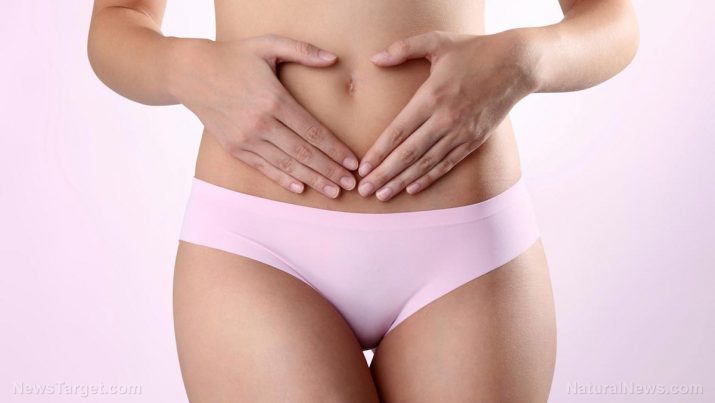
Women, are you aware of these TOXINS found in common feminine products?
Tuesday, July 24, 2018 by Zoey Sky
http://www.products.news/2018-07-24-women-are-you-aware-of-these-toxins-found-in-common-feminine-products.html

While there are various feminine products on the market, not many women are aware that some of them contain toxins. What’s a girl to do when the very thing that is supposed to make her monthly period easier to bear actually contains dangerous chemicals that can cause health problems?
Toxic exposure from feminine products
Even if periods only happen for a week every month in a woman’s life, that still amounts to at least 30 reproductive years that a woman uses pantyliners, pads and/or tampons. These products have direct contact with the vaginal mucous membranes that are highly absorbent. The vaginal area has a lot of blood vessels and lymphatic vessels, which can easily send chemicals it comes into contact with to a woman’s body via the circulatory system.
While the Food and Drug Administration (FDA) regulates these products, pads and tampons are considered medical devices. However, the FDA doesn’t regulate the cosmetic industry or other chemical-laden products too strictly. Remember, anything that the FDA deems safe enough for public use isn’t always 100 percent safe.
Since the products are sold as medical devices, the companies that make them don’t need to reveal everything about the ingredients. Toxin exposure via unexpected sources, like feminine products, may still greatly affect your health. (Related: Yes, women are being poisoned by toxic chemicals from feminine hygiene products.)
Hormone disruptors and chemicals found in feminine products
Feminine products not labeled as organic can contain the toxins listed below:
- Dioxins – Pads and tampons are bleached, and dioxins are produced because of the bleaching process. Dioxins are linked to hormone disruption and autoimmunity while regular tampon use can increase health risks.
- Glyphosate – Cotton, one of the main ingredients of pads and tampons, is a major genetically modified organism (GMO) that’s often treated with glyphosate. Cotton is highly absorbent, which means it also absorbs the chemicals that it’s treated with. At least 85 percent of non-organic tampons contain glyphosate.
- Mercury – Mercury isn’t directly added to feminine products, but it can be found in pads and tampons since it’s a byproduct of the manufacturing and bleaching process. Mercury is connected to the disruption of the digestive, immune, and nervous systems.
- Phthalates – Phthalates are a chemical similar to plastic, and they’re often used in various scented products like pads or tampons. Phthalates, which mask vaginal odors, can disrupt the hormones.
- Rayon – Rayon is a synthetic ingredient made from sawdust and it’s heavily linked to toxic shock syndrome (TSS). Tampons have a warning label that tells women not to leave them longer than eight hours because of TSS. The condition can cause symptoms like diarrhea, fever, low blood pressure, seizures, and vomiting. TSS is fatal but while many women are aware of the condition, not all of them know that tampons can also expose them to dioxins, the byproducts of rayon.
- Synthetic fragrances – Synthetic fragrances make countless products emit a certain smell. These scents help feminine products mask odors, but since the chemicals used in fragrances are often proprietary, they aren’t required to be disclosed so users don’t know what exactly are in the products they buy. Some fragrances can even contain known carcinogens.
Dangers of toxic feminine products
Since women use them for at least 30 years, they’re exposed to these toxins for the duration of their periods. These can often result in dangers like:
- Cancer risk – Dioxins and other ingredients used in women’s hygiene products have cancer-causing components.
- An increased risk of developing infections – The chemicals and synthetic ingredients in feminine products increase a woman’s risk of yeast infection or bacterial vaginosis. These items contain unnatural materials that can disrupt normal and healthy vaginal bacterial balance.
- Reproductive harm – Toxins can affect a woman’s fertility. Hormones are susceptible to disruptions, and the chemicals found in feminine products can endanger the women that use them.
Toxin-free organic alternatives to feminine products
By switching to organic alternatives, you can avoid toxins. Organic feminine products are more expensive than non-organic versions, but they’re worthy investments. These natural alternatives don’t use bleach, and some of them are even reusable and washable, completely eliminating waste.
- Disposable and organic pads, liners, and tampons – These products are convenient and disposable, and they’re unbleached and chemical-free.
- Menstrual cups – Menstrual cups collect menstrual blood and they’re safer to wear even for prolonged periods of time. Menstrual cups can also be used for several cycles.
- Period underwear – These panties are worn during menstruation, and some are designed to be worn without the need for pads or cups. Others can also be used together with reusable pads or cups. Period underwear is made of highly absorbent and leak-proof materials.
- Reusable pads – Reusable menstrual pads are made from cotton and are highly absorbent.
Consider switching to these organic and safer alternatives. Aside from ensuring your safety, these products allow you to reduce the waste that you produce every month. If you’re worried about the additional cost, remember that your health is worth more than toxic feminine products.
Read more articles about the toxins in personal hygiene products and how to avoid them at WomensHealth.news.
Sources include:
Tagged Under: Tags: badcancer, badhealth, chemicals, Dioxins, female fertility, feminine hygiene, feminine products, girls health, glyphosate, Hormone disruptors, menstrual cups, mercury, Organic, period underwear, phthalates, pregnancy, rayon, reusable pads, sanitary napkins, synthetic fragrances, Tampons, toxic chemicals, toxic products, toxins, women's health





